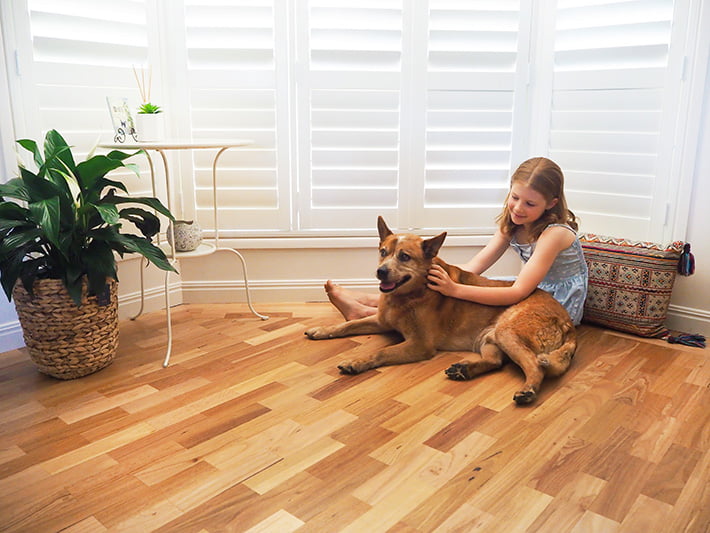The timeless beauty of timber flooring is largely attributed to it being a product that draws the natural environment into our internal living space. There are several different timber flooring applications available ranging from natural timber to those with a timber like appearance. Use our guide to help choose the best timber flooring for your home.
Why Choose Timber Flooring
- The natural elements of timber flooring make it extremely versatile offering a vast array of design options. From warm, elegant tones to a more coastal vibe, the choice is yours.
- Timber flooring is extremely easy to maintain. A quick sweep with an anti-static dry mop will take care of daily dust particles. For a thorough clean – a vacuum, followed by a damp mop will keep your floors looking great.
- A well-maintained timber floor will provide a healthy option for allergy or asthma sufferers, as it won’t harbour dust mites, pet hair and similar allergens.
- Timber floors have minimal environmental impact creating five times less carbon emissions than ceramic tiles (source: CRC for Greenhouse Accounting).
- The options are endless. From timber species to flooring options plus a vast range of coating and finishings, there will be a timber flooring product that will suit your project.
Flooring Types
There are several options of timber and timber related flooring types. The most common timber floor options are:
Timber Flooring
- Solid strip timber flooring
- Engineered flooring
- Parquetry
Timber Related Flooring
- Laminate flooring
- Bamboo flooring
- Cork Tiles
Timber Flooring Options
Solid Strip Timber Floors
Solid strip timber flooring is the most traditional of all timber flooring applications and as such, will never date. It can be fixed directly to joists, sub-floors, or battens, and in some cases directly to a concrete slab. Commonly known as tongue in groove timber flooring, it is known for its strength, durability, and character.
Throughout its life, solid strip timber floors can be rejuvenated to near new condition by sanding and refinishing. Available in many different timber species, it is ideal for new houses or to match existing floors in renovations and extensions. They can be top nailed, or secretly fixed in combination with adhesives. Solid strip timber flooring is usually ready to walk on within 48 hours of completion.
Engineered Timber Floors
Engineered timber flooring is manufactured using a timber veneer bonded over layers of timber beneath – giving the appearance and decorative characteristics of solid timber flooring. Most engineered flooring is pre-finished although some are designed to be sanded and finished after installation.
Engineered floors may be laid as floating floors, glued to a sub-floor as an overlay and, in some cases, fixed as a structural floor on battens. Pre-finished engineered floors are ready to walk on once installed.
Parquetry Floors
Parquetry comes in two forms:
- Block parquetry
- Mosaic parquetry sheet (less common)
One of the more intricate timber flooring systems, when laid by a trained and experienced specialist a parquetry floor can be the showpiece of any home or venue. Available in many options of block size, species and layout, parquetry is similar in nature to solid strip flooring and therefore can be sanded and polished throughout its life.
Timber Related Flooring
Laminate Floors
Laminate flooring typically consists of a timber look finish on a high-density fibreboard core. Over this, a hard-wearing melamine layer is bonded. Laminate floors are always laid as floating floors and can be laid over most surfaces utilising a foam underlay.
Available in a large range of timber patterns, lengths and textures, all current laminate flooring products have a glueless installation system and are ready to walk on once installed. (Source: ATFA)
Cork Floors
Cork Tiles utilise natural cork in tile form which is adhered directly to a sub-floor or underlay. Raw cork is lightly sanded and then coated to provide a natural looking, highly durable surface that is also soft underfoot.
Bamboo Floors
Bamboo is a grass, not a timber, but like timber it is manufactured in board form and shares some characteristics of solid timber. The most common type of bamboo flooring is strand woven which means cut strands of bamboo are bonded together with an adhesive before being cut and machined into floorboards.
In other forms it can be made by gluing small sections of bamboo together – either vertically or horizontally – to create different appearances. Bamboo floors can also be engineered to provide stability when fixed to a slab. (Source: ATFA).
Most bamboo flooring products:
- are pre-finished.
- have glueless joining systems and
- are floated on a foam underlay.
Installation Essentials After You Choose the Best Timber Flooring
There are 3 things to consider when choosing a timber flooring option.
- Lifestyle. The versatility of many flooring applications available will provide several options to suite either a busy household, a quieter lifestyle with less foot traffic, or even a busy workspace.
- Environment. It is essential to ensure that the product suits the local climate, for instance some flooring systems suit a humid/warm climate whereas others suit a dryer/cool climate.
- Budget. Look at all options and chose the best quality possible.
Above all else, always seek advice from a licensed flooring expert who can give you the most accurate and specific information and recommendations for your timber flooring project.

